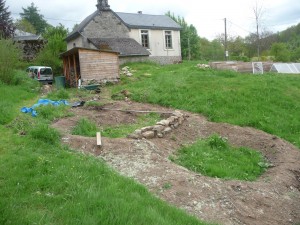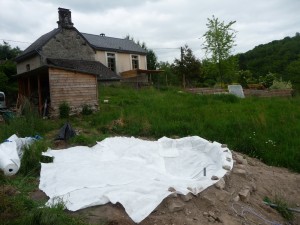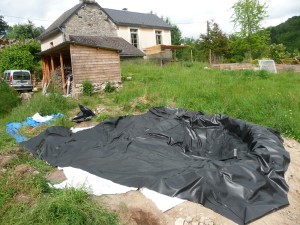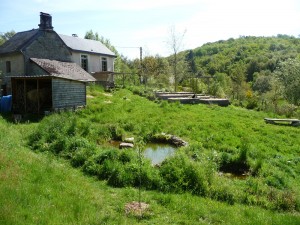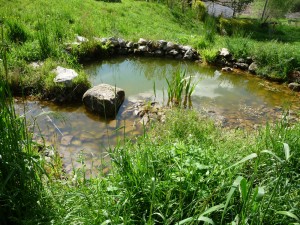 The plan had been to build a natural swimming pool, but we quickly realised that we didn’t have enough space, or the funds to build one, so settled on the idea of a pond that we can sit in.
The plan had been to build a natural swimming pool, but we quickly realised that we didn’t have enough space, or the funds to build one, so settled on the idea of a pond that we can sit in.
Luckily, the only available spot for it happened to be the most naturally placed, and easiest to construct on, a mini-cutting running away from the house. This meant that we could get away with building retaining walls for the water, rather than having to dig down into very rocky ground.
The material for the retaining walls was supplied by many, many wheelbarrows of earth and stone that needed to be shifted when building the terraced vegetable garden.
The basic outline was improvised, the size and rough dimensions dictated by how much pond liner we could afford. It consists of: a small boggy top pond; this feeds into two larger ponds, one shallow and one with a deep section to sit in; these feed into a fourth small, shallow pond, which vents to a sloping section heading to the garden border.
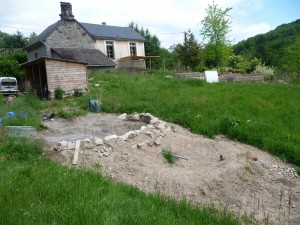 The top soil and grass was removed from the center of these areas, and placed to one side for later use. A deep retaining dry stone wall was built along the bottom edge and sides of the second of the large pools, and a small amount of earth removed to create a depth of about 1.5m.
The top soil and grass was removed from the center of these areas, and placed to one side for later use. A deep retaining dry stone wall was built along the bottom edge and sides of the second of the large pools, and a small amount of earth removed to create a depth of about 1.5m.
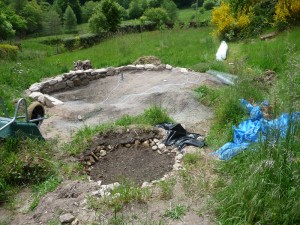 The pond areas were sculpted to try to create a natural-looking space, all the sides except the small deeper section offering shallow gradients to allow easy access for wildlife.
The pond areas were sculpted to try to create a natural-looking space, all the sides except the small deeper section offering shallow gradients to allow easy access for wildlife.
The piece of gray pipe protruding from the soil acts as an overflow, transferring water down to the lower, final pond ( you can see this pipe venting into the lower pond in the picture above ), which has a similar system in place to vent to the bottom of the garden.
The flexible tube in this picture was used to very accurately guage the levels of the retaining walls and sides; it’s called a ‘bunnyip’. These two ingenious ideas were taken from the Organic Pools site, linked above. Their pdf is a great resource.
You can also make out chicken wire in the photo above. This was laid before anything else, to stop mole-rats digging up through the liner.
We decided to do a proper job when lining the pond. This stuff isn’t cheap, even on a small scale such as ours, and so it’s tempting to skimp a bit; miss out a layer of protection; choose a thin plastic membrane instead of a heavy duty rubber-based material.
Each short cut has the potential to cause much distress when a tiny hole opens and your lovingly-created wildlife oasis springs a leak.
So, this first post-chicken wire layer is a high quality, super tough synthetic felt-like fabric. On stoney ground such as this, it’s a must.
Next, the liner itself. One single 7m x 6m sheet. It has to be done in a single sheet because joining sheets is tricky and requires kit, and introduces another ‘potential failure’ variable.
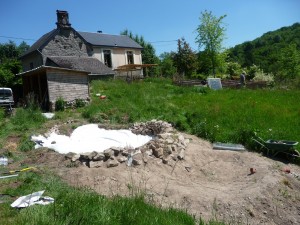 A second layer of felt is layed on top of the liner for protection, the retaining wall built up higher, sides covered with the retained topsoil and grasses, edges fine-tuned.
A second layer of felt is layed on top of the liner for protection, the retaining wall built up higher, sides covered with the retained topsoil and grasses, edges fine-tuned.
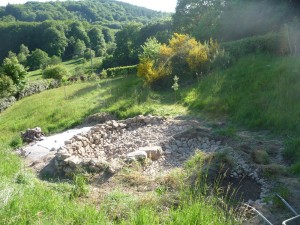 You can if you like fill the pond at that last stage; the fibrous liner will quickly discolour and enable plants etc to root easily. However, we didn’t really like the white aesthetic, had a mass of small stones laying around, and so decided to line the pond with these. We figured that they would seed all sorts of interesting things quickly.
You can if you like fill the pond at that last stage; the fibrous liner will quickly discolour and enable plants etc to root easily. However, we didn’t really like the white aesthetic, had a mass of small stones laying around, and so decided to line the pond with these. We figured that they would seed all sorts of interesting things quickly.
This exercise took much, much time. For some reason it seemed like a good idea to lay them out in such a way as to suggest the flow that the water might take, in the form of a fancy underwater mosaic. When it was finished we were half tempted not to fill it.
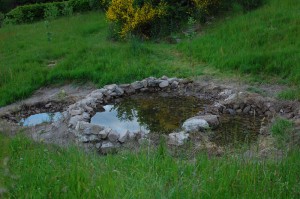 Finally, the ponds were filled. Incredibly, that first night, frogs visited. They must have been watching the construction process and passing word.
Finally, the ponds were filled. Incredibly, that first night, frogs visited. They must have been watching the construction process and passing word.
During the following twelve months the grasses and wild flowers surrounding the pond have fully integrated, and the water blends in seamlessly. What is strange and wonderful is that although we have planted nothing new, a very rich variety of plants have magically appeared, that were not present before the ponds were constructed. 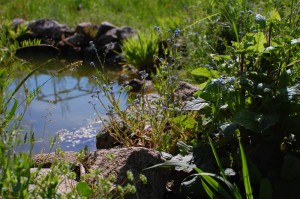
The stone walls have been collonised by plants and flowers that have seeded in the densely-packed earth that was used as a coarse bonding agent. 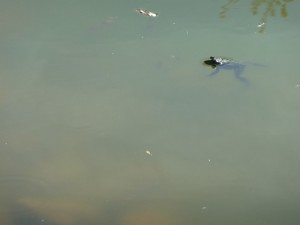
Many creatures too numerous to list very quickly took advantage of the new resource.
It’s a delight. Most days we pop down to take a look at what new surprises await, what subtle changes have manifested themselves overnight.
Because the ponds are gravity fed by rainwater overflowing from the butts, and so have a regular supply of fresh water flowing through, there has been no need to install any form of circulation or filtration system. Sometimes the water does turn a thick green with algae ( a sign of health ), but it has never become stagnant.
We have introduced a few plants from local wild ponds and lakes to help with natural oxygenation and filtration, and expect that over time, it will attain a state of equilibrium that it feels comfortable with. We look forward to whatever surprising results it chooses to offer and reveal.

